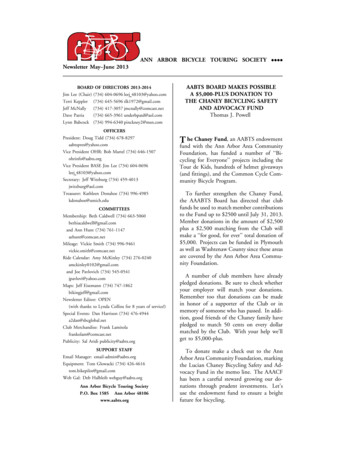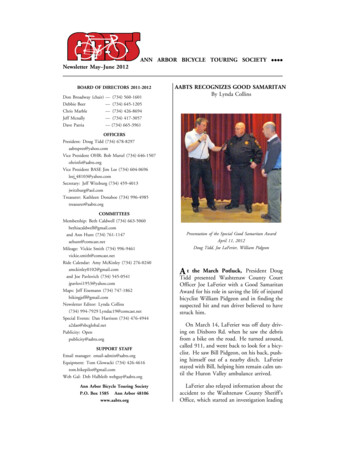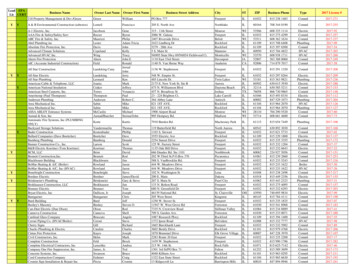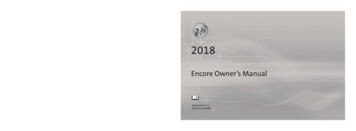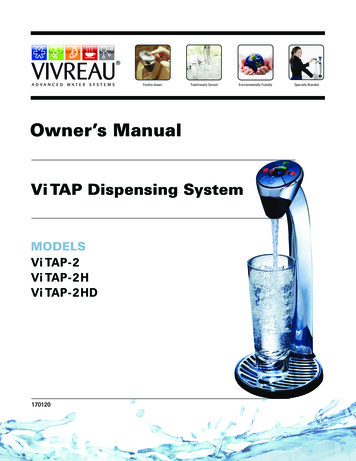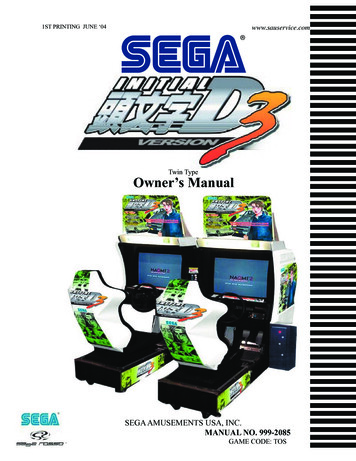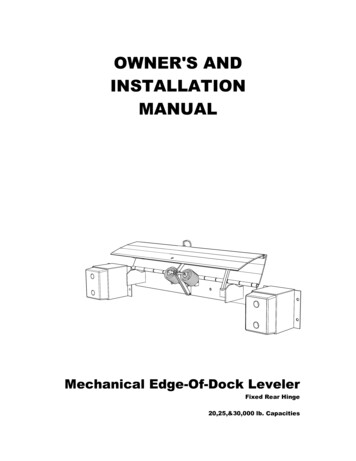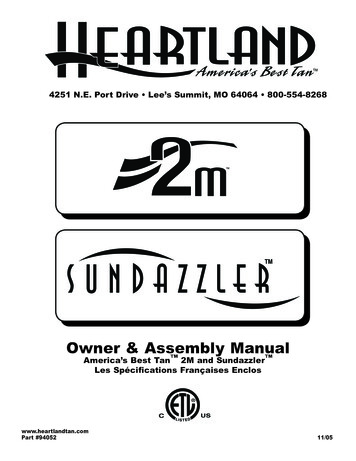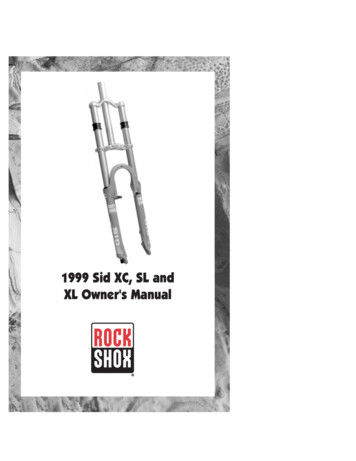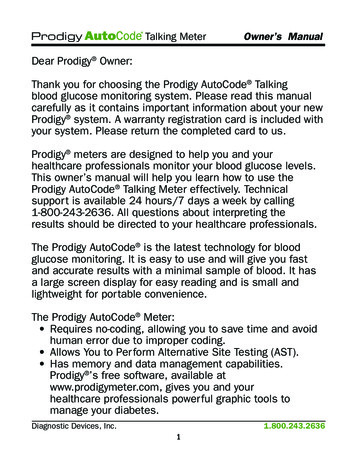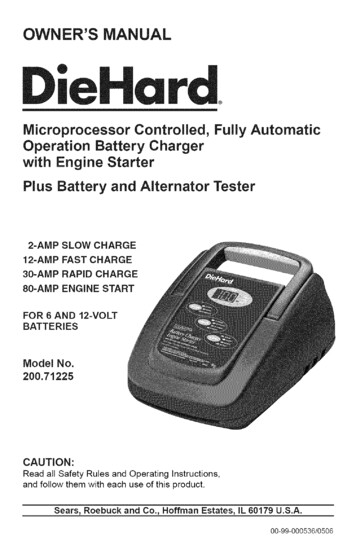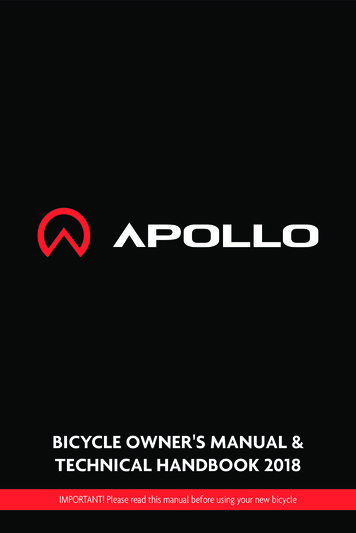
Transcription
BICYCLE OWNER'S MANUAL &TECHNICAL HANDBOOK 2018IMPORTANT! Please read this manual before using your new bicycle
AUSTRALIAN CONSUMER LAW LIMITEDWARRANTY STATEMENT FOR AUSTRALIA(applies to goods sold after 1 January 2012)This warranty is given by Apollo Bicycle Co. Pty. Ltd (ABN 60 001 914 469) of 3/333 Frankston-Dandenong Rd, Dandenong Sth, VIC 3175. Telephone: (03) 9700 9400.Facsimile: (03) 9700 9499. Email: info@apollobikes.com.This limited warranty applies only to the original purchaser of an Apollo, Neo, or Radius bicycle and is not transferable to subsequent owners.Subject to the terms, conditions and limitations set forth below, Apollo warrants to the original purchaser of each new Apollo bicycle (that has a wheelbaseexceeding 640mm or a wheel size of 16” (40cm) or greater.) that Apollo Bicycle Company will repair or replace the frame or fork should it fail at any weld point,provided it was purchased new from, and assembled by, an authorised Apollo bicycle dealer.This limited warranty is void if the bicycle is subjected to abuse, neglect, improper repair, improper maintenance, alteration, modification, an accident or otherabnormal, excessive or improper use.All labour charges and freight charges for warranty services are the responsibility of the bicycle’s owner.Apollo, Neo, and Radius Bicycles are designed for intended use and rider enjoyment, however bicycles are not indestructible; every frameset has a useful lifecycle and may not last forever. The duration of the life cycle will depend upon the type of frame, riding conditions and the care your bicycle receives. The ApolloLimited Lifetime Warranty is defined by the life cycles shown in the following:Item 1: Warranty coverage for Carbon Fibre frames, without rear suspension systems, shall be for a period of 5 years. Frame fatigue shall not be covered under theterms of this warranty on these frames.Item 2: Warranty coverage for Aluminium frames, without rear suspension systems, shall be for a period of 5 years. Frame fatigue shall not be covered under theterms of this warranty on these frames. This excludes BMX/stunt frames and forks.Item 3: Warranty coverage for frames of Hi Tensile steel or Chromoly steel construction, without rear suspension systems, shall be for 10 years. This covers theframe only or fork other than suspension forks. This excludes BMX/stunt frames and forks.Item 4: Warranty coverage for Downhill, aluminium and carbon dual suspension systems and system components shall be for a period of one year, coveringfaulty workmanship or materials making up the suspension system. These frames, except Downhill main frames, are covered under the regular warranty for framesof the same material construction should they fail at any regular weld point. Rear suspension design is not covered under this warranty. The fork is not part of theframe and bushings and other pivot hardware on rear suspension frames are not part of the frame.Item 5: Warranty coverage for BMX/Stunt frame and forks shall be for 3 months.Item 6: Warranty coverage for front suspension systems shall be for a period of one year, covering faulty workmanship or materials only.Item 7: Warranty coverage shall last 12 months from the date of purchase for paint finish and all other parts & accessories. Tyres and tubes are not covered bythis warranty.Item 8: Warranty coverage on electrical parts for Electric Pedal Assist bikes shall be as listed below: Motor - 2 years Battery, Controller, Sensor, Battery Charger - 1 yearThe above warranty coverage periods are subject to all the limitations described below.This limited warranty is not transferable and shall only apply to normal and ordinary use of this product.To obtain service under this warranty, the bicycle should be returned to the authorised Apollo dealer on the same continent from which it was purchased, in anassembled condition, together with a receipt or appropriate proof of purchase document which identifies the bicycle by frame number.Should this bicycle or any part or accessory be determined by Apollo to be defective and covered by this limited warranty, Apollo will at its option, eitherreplace or repair any defective product, part or accessory. Dealer labour charges for installing replacement parts or accessories are not covered by this limitedwarranty. The cost of transportation to and from an authorised Apollo dealer for repair or replacement of any defective part and/or accessory is to be borne bythe owner.The bicycle has not been designed, manufactured or sold for use at any time or place or in any manner whatsoever as a power driven vehicle, motorcross, stuntriding, ramp jumping, acrobatics, or rental, hiring or other such commercial activity and this limited warranty does not cover these acts.EXCLUSIONS FROM LIMITED WARRANTYThis limited warranty does not cover any personal injuries, paint damage, mechanical damage or any other damage or injury due to misuse, neglect, accident,normal wear and tear, abuse, improper use or improper maintenance, corrosion or rusting of the frame or any part or accessory due to exposure to the weatheror exposure to a chemical environment, or modifications to the original specifications or factory fitted components, treatment or assembly of this bicycle. Anyuse of this bicycle which is incompatible with those parts and accessories installed as original equipment by the factory is not covered. The warranty on a carbonframe is voided if the bicycle has been ridden on any stationary trainer which attaches to the rear skewer.The benefits to the consumer given by this warranty are in addition to other rights and remedies of the consumer under a law in relation to the goods or servicesto which the warranty relates. Our goods come with guarantees that cannot be excluded under the Australian Consumer Law. You are entitled to a replacementor refund for a major failure and for compensation for any other reasonably foreseeable loss or damage. You are also entitled to have the goods repaired orreplaced if the goods fail to be of acceptable quality and the failure does not amount to a major failure.For the latest version of this bicycle owners manual, please see apollobikes.comApollo Bicycle Company Pty. Ltd.ABN: 60 001 914 469
Use this owner’s manual as a guide for the recommended maintenanceand safe usage of your new bicycle. Take the time to read and understandthis manual; and for parents of young riders please explain the content toyour child. Please note that it is not intended as a full workshop manual.Please consult a specialist bicycle dealer if:a specific subject is not covered in this manualthe subject matter seems beyond your level of experience or abilityyou have any further questionsCONGRATULATIONSCongratulations on your purchase. Your Apollo bicycle has been fully tested andcarefully produced with performance, comfort and safety in mind.With proper care and maintenance your bicycle will give you years ofriding pleasure.General Warning:It is your responsibility to correctly maintain your bicycle. Failure to maintainor inspect your bicycle may have severe consequences, such as losing control whenriding and falling, which may ultimately result in injury or death.The risk of injury or death due to falling is implicit in the many “warnings” and“cautions” stated in this manual. As such, whenever the risk of falling is stated we donot repeat the warning of possible death or injury.Please Note:Bicycle frames and components do not have an infinite life span and must beassessed on an appropriate timeline by a qualified expert.Know how to operate all standard and accessory equipment on the bicycle.Ensure that anyone who uses the bicycle has been fully instructed in the operationof bicycle functions.Your bicycle conforms to relevant Australian Standards. Other local regulations mayapply. Check with your bicycle retailer.This is a partially assembled bicycle requiring final assembly and adjustments beforeriding. Final assembly and adjustment should only be carried out bya qualified bicycle mechanic at your specialist bicycle store.For the latest version of this bicycle owners manual, please see apollobikes.com1APOM0518Apollo Bicycle Company Pty. Ltd.ABN: 60 001 914 469
DIRECTORYPART 1PART 2WarrantyParts ClassificationInside Front CoverPages 4 – 7PART 3PART 4Before You RideBicycle Care & ServicingPages 8 – 21Pages 22 – 26PART 5PART 6Comprehensive MaintenanceFolding Bicycle InstructionsPage 27 – 67Page 68PART 7PART 8Electric Bicycle ManualContact AddressesPages 69 – 76Back CoverWarning /Important(take notice of this symbolthroughout this manual)2APOM0518Apollo Bicycle Company Pty. Ltd.ABN: 60 001 914 469
6161717171818192020212222222223242526272727- Tyre inspection28- Recommended tyre pressures28- Front wheel removal & replacement29- Rear wheel removal & replacement30- Correct quick release axle setting31- Hub bearing adjustment & lubrication32- How to fix a flat tyre33- Tyre valve34Steering System35- Handlebar stem35- Handlebar / forks36Bicycle suspension37- Headset38- Quill type assemblies38- 'A-head Set' type assemblies38- Rotor installation & adjustment40Saddle & Seat Post41Brakes43- Sidepull callipers44- Linear pull45- U-brake47- Disc brake48Drivetrain49- Pedals49- Clipless pedals50- Crank set52- One piece crank set53- Cotterless cranks (three piece)54- Chain56- Freewheel57- Coaster hub58Derailleur Systems59- Rear derailleur60- Front ng666. FOLDING BICYCLE INSTRUCTIONS 687. ELECTRIC BICYCLE MANUAL69Basic overview69Shimano Steps models69Range on a full charge71Safety72Operation of pedal assistance & direct power73Maintenance75Battery charging768. CONTACT ADDRESSBack coverINDEX2. PARTS CLASSIFICATIONMountain bicycles & Cross bicyclesSuspension bicyclesBMX/Loop frame/U-Frame bicyclesRoad bicycles3. BEFORE YOU RIDECorrect Frame SizeRiding Position- Saddle height- Reach- Handlebar height- Controls Position AdjustmentSafety Checklist- Brakes- Wheels & tyres- Saddle- Steering- Chain- Bearings- Cranks & pedal- Derailleur- Frame & fork- Suspension- Accessories & safetyHelmetsRiding Safely- General rules- Wet weather riding- Night riding- Pedalling technique- Hill technique- Cornering technique- Rules for childrenGears - How to Operate- Derailleur gears- Operating principles- Hand grip shifters- Below the bar shifters- Dual control shifters4. BICYCLE CARE & SERVICING- Basic maintenance- Storage- Security- Special instructions for care of carbonfibre bicycles- Schedule 1. Lubrication- Schedule 2. Service ChecklistTorque Requirements & Tools Required5. COMPREHENSIVE MAINTENANCEWheels and Tyres- Wheel inspection3APOM0518Apollo Bicycle Company Pty. Ltd.ABN: 60 001 914 469
PART 2 - PARTS IDENTIFICATIONFinding the bicycle to best suit your needs is made easy by the vast array of bicycle models andsizes available. Refer to the following diagrams to familiarize yourself withthe names of the various parts on your bicycle.WARNING: Handlebar handgrips or tube-end plugs should be replaced if damaged.Unprotected tube-ends can cause injury. Bicycles used by children should especiallybe checked to ensure bar end handgrips are in good condition.Mountain Bikes & Crossbikes.Mountain bikes are one of the most versatile bicycles. Wider wheel rims and tyres ensuremaximum comfort and traction over a wider variety of surfaces and the frame and forksare strong, making them particularly suitable for rough terrain. Manoeuvring is made easier bythe wider handlebars and convenient shift lever position. The Crossbike or hybrid blends featuresof the mountain and racing bicycles. Its frame is lighter than a mountain bike but heavier than aracing bicycle, providing stability and comfort with increased speed.Top TubeSeatSeat PostSeat Post Binder BoltSeat StayRear ReflectorRear BrakeWheel ReflectorShift LeverBrake LeverHandlebarBrake Control CablesFront ReflectorFront BrakeWheel ReflectorFront ForkHandlebar StemHead SetHead TubeSeat TubeDown TubeFront DerailleurRear GearControl CablePedalCrank ArmChainwheelChainstayChainFreewheelGear Control CableRear Derailleur4APOM0518Apollo Bicycle Company Pty. Ltd.ABN: 60 001 914 469Tyre ValveRimTyreFront HubSpokes
Suspension Bikes.Suspension bicycles aim to maximize comfort and traction over rough terrain. The basis ofthe mountain bike frame is blended with suspension – either suspension front forks only or incombination with a rear suspension mechanism built into the frame. A special shock absorbingseat pillar may also be present for improved rider comfort. Despite the variety of suspensionbikes available the basic components are similar in all models, such as wide rims and tyres forincreased traction and comfort.HandlebarHandlebar StemShift LeverBrake LeverControl CablesHead SeatSeatSeat PostSeat TubeSeat Post Binder BoltRear ReflectorBrake Control CableGear Conrol CableRear Suspension DamperTop TubeFront DerailleurReflectorUpper Fork (Suspension)Down TubeSuspension MountingHead TubeProtective BootFork BraceFront BrakeLower Fork (Suspension)Rear BrakeRear Frame Sub AssemblyPedalWheel ReflectorGear Control CableFreewheelRear DerailleurCrank ArmBottom Bracket AxleChainwheelChainstayDrive ChainTyre ValveRimTyreFront Hub AxleSpokes5APOM0518Apollo Bicycle Company Pty. Ltd.ABN: 60 001 914 469
BMX Bicycles.BMX style bicycles are ideal for young riders. Their durable, simple design makes them perfectfor general purpose use with minimal maintenance required. Alternative frame styles, such asU-shape frames and loop frames, may also be used for other varietiesof children’s bicycles.WARNING:General purpose freestyle and BMX bicycles are notdesigned for stunting, racing, or competition use.Crash PadHandlebar StemHead SetHead TubeTop TubeSeatSeat PostSeat Post Binder BoltSeat StayRear ReflectorWheel ReflectorHandlebar GripBrake LeverHandlebarBrake Control CableReflectorFront BrakeBrake PadFront ForkWheel ReflectorCrash PadSeat TubeDown TubeChain GuardCrank ArmPedalRear SprocketTraining WheelChainwheelChainstayChain6APOM0518Apollo Bicycle Company Pty. Ltd.ABN: 60 001 914 469Tyre ValveRimTyreFront HubSpokes
Road Bicycles.Road or racing bikes aim to cater for fast travel over long distances on smooth surfaces. Framesare light weight and rims have a narrower profile, for maximum efficiency and speed.Brake Control CableFront ReflectorBrake/Shift LeverTop TubeSeatSeat PostSeat Post Binder BoltSeat StayHandlebar StemHandlebarHead SetHead TubeRear ReflectorRear BrakeWheel ReflectorFront BrakeBrake PadWheel ReflectorSeat TubeFront ForkDown TubeFront DerailleurBottom Bracket AxleToe StrapToe ClipPedalCrank ArmChainwheelSpoke Protector Disc.Rear DerailleurFreewheelRear DropoutChainstayChainTyre ValveRimTyreFront HubSpokes7APOM0518Apollo Bicycle Company Pty. Ltd.ABN: 60 001 914 469
FRAME SIZEPART 3 - BEFORE YOU RIDEChoosing the appropriate frame and wheel sizeis imperative when purchasing a new bicycle.For safe riding the size of your bicycle should properlymatch your build. In the case of children, a bike shouldnever be bought with aim of “growing into it”. Ridingthe appropriate sized bicycle enables the child todevelop confidence, as they have the necessary coordination to control the bicycle. To accommodate thevast array of height and size variables in children, evenwithin the same age groups, juvenile bicycles come indifferent wheel sizes and frame styles to best suit therider’s size.Ladies and gents’ bicycles are also available in a varietyof frame sizes. Sizing is based on the distance betweenthe centre of the bottom bracket and the top of theframe seat tube.Female riders should take into account the slopeof the top tube to determine frame size suitability.WARNING:For safe riding your bicycle should matchyour size correctly, otherwise you may losecontrol and fall. Ideally there should bea minimum clearance of 25mm betweenthe crotch of the intended rider and thetop frame tube of the bike, while the riderstraddles the bicycle with both feet flat onthe ground.Clearance over the top of the frame ensures that therider can safely stand astride the bike when forced outof the saddle, such as stopping attraffic lights. Clearance heights vary accordingto rider preference and between the different bicyclemodels.8APOM0518Apollo Bicycle Company Pty. Ltd.ABN: 60 001 914 469
Please refer to the chart below to assist you in making the correct choice.If you have any queries refer to your dealer.Bicycling Sizing GuideApprox. riderInner leglengthApprox.AgesWheel Size(kid’s models)Suggested FrameSize for Road BikesSuggested Frame Size forMountain or Hybrid Bikes40cm min.46cm min.55cm min.61cm 4cm4-65-106-1412-1612 plus12 plus12 plus12 plus12 plus12 plus12 m(19.5”)52cm(20.5”)53cm(21”) - 56cm(22”)58cm(23”) - 60cm(23.5”)9APOM0518Apollo Bicycle Company Pty. Ltd.ABN: 60 001 914 469
RIDING POSITION1. Saddle HeightTo ensure pedalling efficiency, safety and ridercomfort it is crucial that the seat is set at the correctheight. The rider’s leg length is used to determinethe appropriate saddle position. When the seat ispositioned correctly the rider’s leg should not strainfrom over-extension and the hips should remainlevel when pedalling. To establish seat height sit onthe bicycle with one pedal at its lowest point, andplace the ball of the foot on that pedal.If the knee is slightly bent in this position thenthe seat is at its correct height. The leg should bepractically straight when the heel of that foot isplaced on the pedal.Caution:Ensure the seat pillar post does not extend beyond the minimum insertion mark.(Refer to Page 42 on how to adjust the seat height). Take special note if your bicycle isfitted with a suspension type seat post.WARNING:Do not replace the seat post with a post which is: A) not of the same diameter orB) longer than the original. Either will void the warranty and could lead to seat postfailure, loss of rider control and injury.2. ReachWhen riding it is important not to overextend one’s reach. To determine the ideal positioningplace your elbow against the seat and stretch out your arm toward the handlebars. The distancebetween the handlebar and the outstretched fingertips of the arm should be 20mm – 50mm. Thisdistance can be adjusted by altering the location of the seat in relation to the seat pillar. (Refer toPart 5 on how to adjust the seat clamp)Arms not over extenededHandlebar stem heightabout the same as seat heightPedal at bottom position10APOM0518Apollo Bicycle Company Pty. Ltd.ABN: 60 001 914 469
3. Handlebar HeightIt is recommended you try various handlebar heights to find the most suitable position foryou. Usually it is most comfortable when the handlebar height is the same as the height ofthe seat. The handlebar stems of some bikes can be altered to customizefit even further.Caution:Stem Wedge BoltEnsure the handlebar’sstem does not extendbeyond the minimuminsertion mark. (Refer toPart 5 on how to adjustHandlebars).Handlebar Binder BoltMaximum Height/Minimum Insertion MarkExceeds 2 1/2" (64mm)WARNING:The steering actionmay be compromisedif the stem binder bolt,the handlebar binder bolt or thebar end extension clamping boltsare not sufficiently tightened. Thiscould result in the rider losing control and falling. To check, try to twist the handlebar/stemassembly whilst the front wheel of the bike is positioned between your legs. If the stemtwists in relation to the front wheel, the handlebars turn relative to the stem, or the bar endextension rotates in relation to the handlebar, the bolts needto be tightened.4. Controls Position AdjustmentThe brake and shifting controls on your bicycle are positioned where they work best for mostriders. The angle of the controls and the position on the handlebars can be changed. Askyour bicycle retailer to make the adjustments for you.REAR BRAKE LEVERFRONT BRAKE LEVERREAR BRAKE LEVERFRONT BRAKE LEVERWARNING:Front wheel brake lever must be mounted on the right hand side; rear brake leveron the left hand side.11APOM0518Apollo Bicycle Company Pty. Ltd.ABN: 60 001 914 469
SAFETY CHECKLISTSafety checks are an important part of any ride. In conjunction with therecommended maintenance in Parts 4 and 5 of this manual it is also suggested that athorough inspection should be undertaken fortnightly, tightening all nuts and bolts,replacing worn and damaged parts and ensuring all components are in their correctpositions. For further details please referto Parts 5 and 6.WARNING:Body parts and other objects should be kept clear from the moving components ofthe bicycle when in use, such as the spinning wheels and the moving chain. Whenriding always wear appropriate footwear – i.e. shoes that will grip the pedals andno sandals. Refrain from jumping with your bike. Jumping puts enormous stress onmany components of your bicycle, especially your front fork.Prior to every ride please complete the following safety checks.1. Brakes- Check front and rear brakes are working correctly- Check brake control cables for wear and ensure they are oiledand properly adjusted- Check brake control levers are lubricated and securely fastenedto the handlebar.- Check brake shoe pads for wear and their positioning in relation to the rims2. Wheels and Tyres- Check tyre pressure is as recommended according to the specification displayedon the tyre sidewall- Check tyres for tread and ensure they do not have any bulgesor excessive wear.- Check all wheel spokes are firm and are intact- Check rims run true and are without any obvious buckles or kinks- Check that axle nuts are tight. For bicycles equipped with quick release axles,ensure locking levers are tensioned appropriately and in theclosed position.3. Saddle- Check the clamp underneath the saddle is firmly securedto the saddle post- Check frame clamping mechanism is tightly fastened- Ensure that the minimum insertion mark cannot be seen on the saddle pillar12APOM0518Apollo Bicycle Company Pty. Ltd.ABN: 60 001 914 469
4. Steering- Check that the handlebar and stem enable correct steeringand are properly adjusted and tightened- Check that the setting of the handlebars is correct in relation to the forks andthe direction of travel- Check the head set locking mechanism is appropriately fixed and fastened- If handlebar extensions are fitted check they are positionedand secured correctly- Ensure the minimum insertion mark cannot be seen on the handlebar stem- Ensure the ends of the handlebars and bar ends are covered or capped.5. Chain- Check the chain is lubricated, clean and runs freely- In wet or dusty conditions service the chain more frequently6. Bearings- Check headset, wheel bearings, pedal bearings and bottombracket bearings- Check all bearings are oiled, run smoothly and show no signs of excessmovement, grinding or rattling7. Cranks and Pedals- Check cranks are securely fastened to the axle and are straight- Check pedals are properly and firmly attached to the crank8. Derailleurs- Check the front and rear mechanisms are operating appropriately- Check control levers are securely anchored- Check derailleurs, control cables and shift levers are sufficiently lubricated- If the gear components come with a separate, specific manual, refer to this forfurther information9. Frame and fork- Check that the frame and fork are straight and intact.- Replace if either is bent or broken.10. Suspension (if applicable)- Check that components operate smoothly with no binding. Keep cleanof grit, and lubricate top of outer leg seal.- Check that all components of the fork & rear suspensionare properly tightened- Check the rear suspension components for excessive wear or side play- If the suspension components come with a separate, specific manual, refer tothis for more in depth information13APOM0518Apollo Bicycle Company Pty. Ltd.ABN: 60 001 914 469
11. Safety & Accessories- Check that all reflectors are attached correctly andvisible- For riding at night, fit fully functioning dynamoor battery powered lights- Check that the bell is fully operational- Check all additional components on the bikeare appropriately secured and functioning- Ensure the bicycle rider and any passengerin a child seat are wearing helmetsHELMETSWhen riding your bicycle it is recommended thatyou always wear an appropriately fitting, AustralianStandards Approved bicycle helmet. This also appliesto any passengers you may carry in a child safety seat.A bicycle helmet must:- carry the Australia & New Zealand Standardsapproved mark AS/NZS 2063 label- fit properlyThe helmet should be:- well ventilated- comfortable- lightweightThe wearing of helmets is mandatory in mostAustralian states. Non-compliance mayresult in an enforceable penalty.14APOM0518Apollo Bicycle Company Pty. Ltd.ABN: 60 001 914 469
RIDING SAFELYGeneral Rules- The same road rules used for vehicles apply to cyclists.Obey the road rules at all times, suchas giving way to pedestrians, and stoppingat red traffic signals- Notify the Road Traffic Authority in your state if furtherinformation is required.- Ride on the left side of the road and never against thetraffic.- Take extra care when attempting to overtake othervehicles and at intersections.- Indicate intended actions, such as turning or stopping, byusing appropriate hand signals.- Ride predictably and in a straight line.- Always ride defensively. You may be difficult to see toother road users.- Closely observe the riding terrain. Avoid obstacles suchas pot holes, gravel, wet road markings, oil, curbs, speedhumps and drain grates.- Be alert. Watch for such things as motorists openingdoors or backing out of concealed driveways.- Sound your bell for a warning when required.- Train and tram tracks should be crossed at a90 degree and preferably walk your bicycle over.- Know how your bicycle operates. Practice braking, gearshifts and if fitted, using toe clips and straps.- Always apply the rear brake first, then the front whenbraking. The front brake is more potent and if it is notused properly you may loose control and fall.- Allow reasonable space between yourself and othervehicles and objects when riding and stopping.Take note of weather conditions and its possible impacton safe braking distances. e.g. Wet riding surfacesincrease braking distances.- Use leg clips or elastic bands if you are wearing loosetrousers to stop them catching in the chain.- Ensure your vision or control of the bicycle is notobstructed by any items you may be transporting.- Do not use items that may impede your hearing.e.g. Headphones15APOM0518Apollo Bicycle Company Pty. Ltd.ABN: 60 001 914 469
Wet Weather- Ride more cautiously in wet weather.Avoid sudden braking, slow overall riding pace andapproach corners more carefully.- Brake sooner, stopping distance increasesin wet conditions.- Remember pot holes and slippery surfaces suchas line markings and tram tracks all become morehazardous in the wet.Try to avoid where possible.- Cornering traction will also be reduced in wetweather.Night Riding- Wear reflective and light coloured clothing.- Reflectors should be fitted correctly to the bicycleand clearly visible. (Refer to Part 5of this manual.)Riding in the dark should never beundertaken without fully operational frontand rear bicycle lights. The use of bicyclelights is mandatory for night riding in mostAustralian States.- Attach a fully operational lighting set.Lights should have a white front lampand a red rear lamp.- Use a flashing rear light to improve visibility.- Charge batteries if battery powered lightsare to be used. Check wiring connectionsfor dynamo powered lights.- Avoid riding at night if possible. If not, slow downand opt for familiar roads with street lighting whenable.Pedalling Technique- Place the ball of your foot on the centreof the pedal.- Ensure your knees are parallel to the bicycle framewhen pedalling.- Keep your elbows slightly bent. This will helpto absorb shock.- Learn how to use the gears correctly (Referto Pages 18-21 in this part of the manual).16APOM0518Apollo Bicycle Company Pty. Ltd.ABN: 60 001 914 469
Hill Technique- Prior to a climb, gear down and continue gearing down as necessary in order to sustain pedallingspeed.- By standing up on your pedals you will be able to generate greater power from each turn of thepedal. This is useful if you are straining and are using the lowest gear.- Use the high gears on a descent to prevent rapid pedalling.- Take extra care when descending. Do not exceed a comfortable speedand maintain control.WARNING:Downhill mountain biking can be a dangerous activity. To reduce the likelihoodof injury appropriate safety equipment should be worn and ensure that yourbike is working perfectly. Follow all of the above instructions.Cornering Technique- Before entering a corner brake slightly and begin to lean your body into the corner.- The inside pedal should be held at the 12 o’clock position and the inside knee angled slightly inthe direction you are turning. The other leg should be kept straight.- Avoid pedalling through fast or tight corners.Rules for ChildrenAny child bicycle rider needs to be taught correct riding skills and behaviour, particularlyaddressing safety, before they take to the streets. Hopefully by doing so accidents canbe avoided.1. Always wear a correct fitting helmet2. Follow all road rules, especially stop signs and red lights3. Always proceed with caution before entering a street. Only enter if thereis no traffic approaching.4. Avoid riding on driveways or the road5. Do not ride on busy streets6. Be conscious of other road vehicles in the vicinity7. Avoid night riding8. Take extra care when riding downhill. Slow down using the brakes and maintaincontrol of the steeringAs suggested by the Consumer Affairs Department riding
Finding the bicycle to best suit your needs is made easy by the vast array of bicycle models and sizes available. Refer to the following diagrams to familiarize yourself with the names of the various parts on your bicycle. Mountain Bikes & Crossbikes. Mountain bikes are one of the m
